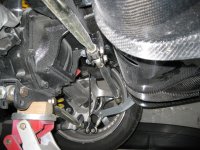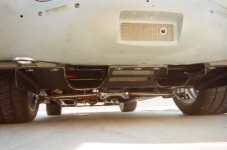TT, with some quick measuring I did some weeks ago. The distance between the half shaft and camber rod is 2" greater at the wheel vs. at the diff. So static the camber rod is not at it's longest point. However the half shaft is and being even shorter, it's arc is faster inward then the camber rod. So it's mainly the half shaft that causes the toe out I think. If you lowered the camber rod as with the Smart Strut it would be flat out!
Anyhow are you suggesting if I corrected the toe issues. I can disregard and not be concerned about camber?
With regard to what Marck said, I think you're confusing a few things. He was specifically addressing the weird toe change our suspension goes through during its travel. While not exclusive, this has less to do with halfshaft vs. strut rod length. Our suspensions effectively make two A-arms with a single common point, that being the front pivot point at the front of the trailing arm. For the upper, the other two points are the inner and outer half shaft yokes. For the lower, the two strut rod points. Since there is no other means of controlling toe, it is solely dependent on what the trailing arm does. Now the toe, in theory, is set at 0 static, but any movement of the suspension in either direction results in an immediate and proportional increase in toe change off center. This induces a bunch of wonky handling issues. The fix came with the c4. A major improvement was the use of dual links to replace the single trailing arm, giving the car a much longer effective center point for the front pick up. While the actual pick up points were relatively unchanged from the c3, the effective pick up point of the new configuration moved the point at which the two a-arms intersect much closer to the front wheel. That does a lot for minimizing the changes in suspension through its arc of travel. Secondly, the hub was isolated from those links and instead relied on a toe rod connected to the rear of the differential carrier in parallel with the halfshafts to maintain the toe settings throughout the arc of travel. This cured a bunch of the inherent "rear wheel steering" inputs designed into the c2/c3 platform.
Now as far as camber is concerned, the c4 design is still very similar to the c2/c3 design. Building in a little controlled camber change in cornering can be a very desirable thing. I'm not sure what you mean by "overcambering". I know the drag racers like the Smart Struts because they remove the camber induced during suspension compression (squat) at launch. That squat rolls both tires in at the top, reducing the amount of tread in contact with the pavement at the worst possible time.
However, that "problem" is actually far more desirable in high speed cornering. The outboard tire will camber negative (in) as the suspension compresses and the inboard tire will camber positive (out) as the car rolls toward the outside of the turn. When dialed in, this can be a very good thing by maximizing the amount of tire that maintains contact with the pavement throughout the arc of the turn.
Hope I don't sound like I'm talking down to you (or others) I just don't know how much you understand about the suspension dynamics. For the record, most of what I know I've learned here and reading suspension books, and half of that is probably wrong.


